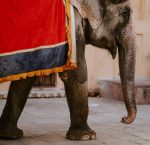Have you ever seen the announcement of animal circus? Or, have you ever attended one of them? We all know, under the colorful spotlights, sparks, and confetti, animal circus looks extravagant. It is ecstatic to see elephants in colorful hat playing with balls, tigers jumping into ring fires, or dolphins that swim beautifully with human. However, have you ever wonder about what is behind the curtain?
Circus is not something that we aren’t familiar with, and animals, especially the wild ones, have been used in it for time to time. Little that we know how the animals are mistreated when they are not performing. Sadly, lots of them are suffering from abuse and stress, either behind bars or chained.
Nowadays, along with the awareness about animal rights, many countries have banned wild animals or domesticated animals (such as dogs) in circuses. At least, there are more than 20 countries across the world that are pretty progressive with this regulation.
Wild Animals Banned in Circus; How’s Their Mental Health Condition
Repetitive abnormal movements and positions
Lots of wild animals are suffering from abuse throughout their lifetimes in circuses. In many cases, when they are not performing, the circus animals are confined into small cages and they spend most of their time in it. The cages are usually are not big enough for them but only to stand and turn around. Remember that wild animals usually can spend a lot of their time roaming around the places. For example, wild elephants usually walk up to 50 kilometers a day in the wild. Elephants in the circus usually don’t get this opportunity at all. Travel circus can be even worse.
Due to the lack of movements and activities as well as unnatural tricks that they repeatedly do in the performance, the animals can develop extreme frustration. They adapt to all of these stressful situations and shut down mentally. It is found that animal circuses, like elephants, tigers, lions, and parrots are adopting repetitive abnormal movements, positions, and pacing such as rocking back and forth and even go far into self-destructive. These mental issues can lead to physical problems such as joint issues, hernia, rheumatoid disorders, injured from self-harm, weight loss, and lameness.
Stressed due to lack of companionship
Most of the wild animals that usually use in circus, like tigers, lions, and elephants are communal animals who live in a group by nature. However, when they took as a circus performer, they are usually taken away from their families or their group at a young age. And surely, the circus doesn’t need dozens of elephants from the same community into one cage, right? So the elephants are brought up alone and then forced to stay in isolation. Because of that, they might develop stress from loneliness, which leads to more extreme conditions such as extreme frustration, depression, anxiety, or post-trauma disorder.
Traumatic training to keep them submissive
Have you ever wonder how could an elephant stand with only one leg? They surely trained well, but how does the training work? Sadly, the training is usually not as cheerful as how it performs. It is mostly such a horrifying and disturbing situation. The animals are forced to learn the tricks with barbaric methods that often use physical punishments.
The animals are beaten with bullhooks or whips so they can ‘learn’ the tricks properly. They are also forced to be chained in tight collars and got their teeth and claws removed to make them harmless to the trainer. This physical abuse is surely injured them and left the animals with bleed and bruised but it also left them with traumas. Can you imagine how scared they are after beaten down?
Besides physical punishment, the circus animals might also be forced to go without basic needs such as food or water as a way to punish them when they don’t do well in training or performing to keep them obey the orders and be submissive.
Stressed by the loud noise and lights
Even after the training, performing can also be traumatic. The wild animals might still feel uneasy on the stage. The circus is usually flooded with the crowd who cheers loudly. The performance itself filled with loud music and dizzying lights from the colorful spotlights. Again, this environment is completely different from their natural habitat which is calmer and shooter. All those sounds and lights can cause stress to them, which then might lead to abnormal behaviors, anxiety, and other physical health issues in the long period.
Until here, we know those wild animals are prone to be mistreated in circuses, not only in the training but even also in the performing. They are forced to live in tiny cages, stayed behind bars for such a long time, forced to wear tight collars while getting beaten down to learn tricks, without proper basic needs. All of these stressful situations in the circus then force the animals to ‘adapt’. They get frustrated until mentally shut, become scared and submissive from the traumatic and overwhelming situations, and also impact them physically, from getting injured and bruised until more serious health problems.
If you agree that animal circus should be banned because of the mistreats toward animals and you care about the wild animals’ mental health, there is something that we can do to help.
Help to raise awareness about how the animals in the circus are treated and keep in mind that wild animals always belong to the wild. They should not belong in tiny cages only for an entertainer. Animals are more than ‘performers’ and are not toys. They are completely live beings who can feel sad and scared. Elephants, tigers, dolphins, bears should not be in a circus. Boycott any animal circus and encourage our local governments to make some strict rules to ban wild animals in any circuses. End the barbaric and cruelty toward wild animals!

